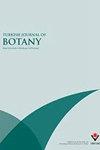Stachydeae(Lamiaceae)部落的花粉和毛状体形态及其系统发育意义
IF 1.5
4区 生物学
Q3 PLANT SCIENCES
引用次数: 0
摘要
: Stachydeae族共有12个属,分为两大支系:Melitis和Eurystachys支系,包括除Melittis外所有属于Stachydeae的属。最近,一个广泛定义的Eurystachys分支归入12个支持良好的分支,在系统发育命名法中被正式命名。本研究利用扫描电镜(SEM)对9属70种蝇的毛状体和6属53种蝇的花粉进行了研究,以期得出竹足科的分类结论。毛状体特征可以提供足够的分类划分差异,包括腺状或非腺状毛的存在与否,细胞数量(单/双/多细胞),极长毛的存在(即超过1000 μm),分支毛的存在以及腺状毛的类型(盾状或头状,有三种亚型:无柄到近无柄,短柄和长柄毛)。在所调查的性状中,极长的简单毛和分枝毛是无形的,分别在Eriostomum和Marrubiastrum分支中发现。此外,花粉粒的孔洞数量、雕刻类型和光腔形状等主要特征,特别是对Eriostomum枝、Empedoclea枝、Sideritis枝、Marrubiastrum枝和Swainsoniana枝等自然类群的划分提供了有价值的特征。此外,我们的研究结果还表明,Sideritis的两个年生分支(即Hesiodia和Burgsdorfia)各代表一个剖面,它们之间存在密切的关系。然而,在Stachys和Olisia两种形态异质的进化枝中,雕刻类型表现出变化,并且主要用于物种区分。总体而言,毛状体和花粉特征与其他可靠的形态学特征一起,可用于描述系内的自然类群。本文章由计算机程序翻译,如有差异,请以英文原文为准。
Pollen and trichome morphology of tribe Stachydeae (Lamiaceae) and itsphylogenetic significance
: Tribe Stachydeae with 12 genera were divided into two major clades: Melitis and Eurystachys clades consisting of all genera attributed to Stachydeae except Melittis . Recently, a broadly defined Eurystachys clade falling into 12 well-supported clades have been formally named in a phylogenetic nomenclature. In the present study, trichomes of 70 spp. from nine genera and pollens of 53 spp. from six genera were investigated using scanning electron microscopy (SEM) in order to draw the taxonomic conclusion of tribe Stachydeae. Trichome characters that can provide adequate variation in delimitation of taxa were: presence or absence of glandular or nonglandular trichomes, number of cells (uni-/bi-/multicellular), presence of extremely long trichomes (i.e. more than 1000 μm), presence of branched trichomes as well as type of glandular trichomes (peltate or capitate with three subtypes: sessile to subsessile, short-stalked and long-stalked trichomes). Among the investigated characters, extremely long simple trichomes and branched trichomes were apomorphic and were found in Eriostomum and Marrubiastrum clades, respectively. In addition, number of colpi, type of sculpturing as well as shape of lumina as the main features of the investigated pollen grains afforded valuable characters especially in delimitation of several natural groups, i.e. Eriostomum clade, Empedoclea clade, Sideritis clade, Marrubiastrum clade, and Swainsoniana clade. Moreover, a close relationship among two annual clades of Sideritis each of represents a section, i.e. Hesiodia and Burgsdorfia , is suggested by our results. However, in both Stachys and Olisia clades which are morphologically heterogeneous, type of sculpturing shows variation and mostly useful in species discrimination. Overall, trichome and pollen characters can be useful in describing the natural groups within tribe Stachydeae along with other reliable morphological characters.
求助全文
通过发布文献求助,成功后即可免费获取论文全文。
去求助
来源期刊

Turkish Journal of Botany
PLANT SCIENCES-
CiteScore
2.90
自引率
5.60%
发文量
31
审稿时长
6-12 weeks
期刊介绍:
The Turkish Journal of Botany is published electronically 6 times a year by the Scientific and Technological Research Council of Turkey (TÜBİTAK) and accepts manuscripts (in English) covering all areas of plant biology (including genetics, evolution, systematics, structure, function, development, diversity, conservation biology, biogeography, paleobotany, ontogeny, functional morphology, ecology, reproductive biology, and pollination biology), all levels of organisation (molecular to ecosystem), and all plant groups and allied organisms (algae, fungi, and lichens). Authors are required to frame their research questions and discuss their results in terms of major questions in plant biology. In general, papers that are too narrowly focused, purely descriptive, or broad surveys, or that contain only preliminary data or natural history, will not be considered (*).
The following types of article will be considered:
1. Research articles: Original research in various fields of botany will be evaluated as research articles.
2. Research notes: These include articles such as preliminary notes on a study or manuscripts on the morphological, anatomical, cytological, physiological, biochemical, and other properties of plant, algae, lichen and fungi species.
3. Reviews: Reviews of recent developments, improvements, discoveries, and ideas in various fields of botany.
4. Letters to the editor: These include opinions, comments relating to the publishing policy of the Turkish Journal of Botany, news, and suggestions. Letters should not exceed one journal page.
(*) 1. Raw floristic lists (of algae, lichens, fungi, or plants), species descriptions, chorological studies, and plant sociology studies without any additional independent approaches.
2. Comparative morphology and anatomy studies (that do not cover a family, tribe, subtribe, genus, subgenus, section, subsection, or species complexes with taxonomical problems) without one or more independent additional approaches such as phylogenetical, micromorphological, chromosomal and anatomical analyses.
3. Revisions of family, tribe, genus, subgenus, section, subsection, or species complexes without any original outputs such as taxonomical status changes, IUCN categories, and phenological and ecological analyses.
4. New taxa of all plants without any additional independent approaches such as phylogenetical, ecological, chromosomal, chorological and correlational analyses in addition to a detailed macro- and micro-morphological descriptions with quality field and microscopic illustrations of taxonomically important structures and identification key in the taxonomic group.
New records of all plants without any additional independent approaches such as phylogenetical, ecological, chromosomal, chorological and correlational analyses in addition to a detailed macro- and micro-morphological descriptions with quality field and microscopic illustrations of taxonomically important structures and identification key in the taxonomic group may be accepted for peer review if they contain 3 or more new records or taxonomical status update, such as lectotypification, new combinations, transfers, revivals and synonyms.
5. New taxa of algae, lichens, and fungi without any additional independent approaches such as phylogenetical, ecological, chromosomal, chorological and correlational analyses in addition to a detailed macro- and micro-morphological descriptions with quality field and microscopic illustrations of taxonomically important structures and identification key in the taxonomic group.
New records of algae, lichens, and fungi without any additional independent approaches such as phylogenetical, ecological, chromosomal, chorological and correlational analyses in addition to a detailed macro- and micro-morphological descriptions with quality field and microscopic illustrations of taxonomically important structures and identification key in the taxonomic group may be accepted for peer review if they contain 5 or more new records or taxonomical status update, such as lectotypification, new combinations, transfers, revivals and synonyms.
 求助内容:
求助内容: 应助结果提醒方式:
应助结果提醒方式:


